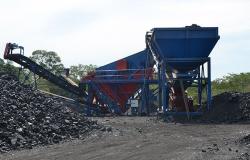
A research team integrated by scientists is developing a technique called orange hydrogen. It seeks to accelerate the natural production of this chemical element and take advantage of it for the energy transition. when it comes into contact with enriched water with carbon dioxide, chemical reaction occurs.
Naturally some rock formations have properties to create this element by oxidation and reduction of other chemicals such as water or iron. The latter reaches approximately 5 percent of the earth’s cortex mass, having the ability to generate a significant amount of hydrogen.
There is an important amount of colors with which this chemical element is used: pink, yellow, orange, gray, turquoise blue or green. The difference between each color is the process that is used to extract and use it; All of them are an important part for the energy transition process.
The use of orange hydrogen occurs mainly in injection and extraction wells. The process is similar to geothermal plants: when loading water with carbon dioxide is injected into the rock cortex by means of a well. When the water filters through the rocks it reacts and releases carbon dioxide.

Geographic limitation
The released gas is enriched with hydrogen so that it is finally recovered by extraction wells. The test technique has worked in rocks with a few centimeters thick; Methods are being applied to expand this operation to other rock thicknesses. There are still technological limitations in the selection and extraction of orange gas.
Scientists have seen that they must change the approach to better make this chemical element; Improvements in technology are required to efficiently extract energy. This innovative process is still in the test phase in laboratories and requires large additional investments.
Experimental option that many discard
Not all regions may benefit in the same way by the use of this energy because the necessary geological formations are distributed only in some regions. An additional challenge is capital investment: although in our country it is being invested to increase this type of energy, it is still under investigation.
The precious gas that appears as a result is captured and used as fuel for other industrial processes, mainly in the petrochemical industry.
Among the various experimental production processes of hydrogen is orange, which many prefer to avoid. It is said that its generation is from non -renewable sources such as natural gas or coal. Its production currently has the emission of carbon to the atmosphere.
Green hydrogen
Through a process called steam, coal or natural gas becomes hydrogen and carbon dioxide. The precious gas that appears as a result is captured and used as fuel for other industrial processes, mainly in the petrochemical industry.
The fact that carbon emissions are released does not end up convincing an important part of users. The most relevant affirm who are against, is the use of waste that is not biodegradable. For that reason, the option of use of green hydrogen that results from clean sources such as sun or wind is being taken.
The most abundant chemical element
Researchers have seen that a double advantage could be had in the orange hydrogen generation process: In addition to producing clean energy, a significant amount of carbon would also be captured. Public policies appropriate for their use must be created, to be environmentally friendly.
In addition, the approach to efficient processes in the generation and use of energy will have to be changed, privileging the one that is clean and green. Recall that hydrogen is the most abundant element, although on our planet it is naturally combined with other elements.
Sustainable solution?
In a short time hydrogen will be the key to the transition process between the consumption of fossil energy and clean energy. Generating green hydrogen is currently two to three times more expensive than orange hydrogen. That is why it is important to develop more efficient and accessible techniques.
Orange gas is in the research and development stage. Through different processes and use of technologies, its production could be generalized by reducing its costs. Could it be the solution that we expect so much in the sustainable use of energy, reducing the environmental impact?
Cleaner and cleaner energy supply
It must work on the application of innovative and adequate technologies that protect the environment. This will depend that resources are preserved for this and future generations also ensuring the increasingly clean energy supply.







